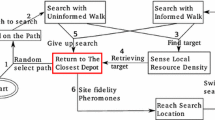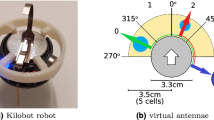Abstract
In multi-robot applications, such as foraging or collection tasks, interference, which results from competition for space between spatially extended robots, can significantly affect the performance of the group. We present a mathematical model of foraging in a homogeneous multi-robot system, with the goal of understanding quantitatively the effects of interference. We examine two foraging scenarios: a simplified collection task where the robots only collect objects, and a foraging task, where they find objects and deliver them to some pre-specified “home” location. In the first case we find that the overall group performance improves as the system size grows; however, interference causes this improvement to be sublinear, and as a result, each robot's individual performance decreases as the group size increases. We also examine the full foraging task where robots collect objects and deliver them home. We find an optimal group size that maximizes group performance. For larger group sizes, the group performance declines. However, again due to the effects of interference, the individual robot's performance is a monotonically decreasing function of the group size. We validate both models by comparing their predictions to results of sensor-based simulations in a multi-robot system and find good agreement between theory and simulations data.
Similar content being viewed by others
References
Beckers, R., Holland, O.E., and Deneubourg, J.L. 1994. From local actions to global tasks: Stigmergy and collective robotics. In Proceedings of the 4th International Workshop on the Synthesis and Simulation of Living Systems Artificial Life IV, R.A. Brooks and P. Maes (Eds.), USA, MIT Press: Cambridge, MA, pp. 181-189.
Fontan, M.S. and Matari?, M.J. 1996. A study of territoriality: The role of critical mass in adaptive task division. In From Animals to Animats 4: Proceedings of the 4th International Conference on Simulation of Adaptive Behavior, P. Maes, M.J. Matari?, J.A. Meyer, J. Pollack, and S. Wilson (Eds.), MIT Press: Cambridge, MA, pp. 553-561.
Galstyan, A. and Lerman, K. 2001. A stochastic model of platoon formation in traffic flow. In Proceedings of the TASK Workshop, Santa Fe, NM.
Gerkey, B.P., Vaughan, R.T., Sty, K., Howard, A., Sukhatme, G.S., and Mataric, M.J. 2001. Most valuable player: A robot device server for distributed control. In Proc. of the IEEE/RSJ International Conference on Intelligent Robots and Systems (IROS 2001), Wailea, Hawaii. Available at http://www-robotics.usc.edu/player/.
Goldberg, D. and Matari?, M.J. 1999. Coordinating mobile robot group behavior using a model of interaction dynamics. In Proceedings of the Autonomous Agents '99.
Goldberg, D. and Matari?, M.J. 2000. Robust behavior-based control for distributed multi-robot collection tasks.Technical Report IRIS-00-387, USC Institute for Robotics and Intelligent Systems.
Holland, O. and Melhuish, C. 2000. Stigmergy, self-organization and sorting in collective robotics. Artificial Life, 5(2).
Lerman, K. and Galstyan, A. 2001. A general methodology for mathematical analysis of multi-agent systems. University of California, Information Sciences Institute, Technical Report ISI-TR529.
Lerman, K., Galstyan, A., Martinoli, A., and Ijspeert, A. 2001. A macroscopic analytical model of collaboration in distributed robotic systems. Artificial Life, 7(4):375-393.
Lerman, K. and Shehory, O. 2000. Coalition formation for large-scale electronic markets. In Proceedings of the International Conference on Multi-Agent Systems (ICMAS'2000), Boston, MA.
Martinoli, A., Ijspeert, A.J., and Gambardella, L.M. 1999. A probabilistic model for understanding and comparing collective aggregation mechanisms. In Proceedings of the 5th European Conference on Advances in Artificial Life (ECAL-99), D. Floreano, J.-D. Nicoud, and F. Mondada (Eds.), volume 1674 of LNAI, Springer: Berlin, pp. 575-584.
Matari?, M. 1992. Minimizing complexity in controlling a mobile robot population. In Proceedings of the 1992 IEEE International Conference on Robotics and Automation, Nice, France, pp. 830-835.
Michel, O. 1998. Webots: Symbiosis between virtual and real mobile robots. In Proc. of the First Int. Conf. on Virtual Worlds, J.-C. Heudin (Ed.), Paris, France, Springer Verlag: Berlin, pp. 254-263. See also http://www.cyberbotics.com/webots/.
Nitz, E., Arkin, R.C., and Balch, T. 1993. Communication of behavioral state in multi-agent retrieval tasks. In Proceedings of the 1993 IEEE International Conference on Robotics and Automation, Atlanta, GE, Vol. 3, L. Werner and Robert, O'Conner (Eds.), IEEE Computer Society Press, pp. 588-594.
Østergaard, E.H., Sukhatme, G.S., and Matari?, M.J. 2001. Emergent bucket brigading—a simple mechanism for improving performance in multi-robot constrained-space foraging tasks. In Proceedings of the 5th International Conference on Autonomous Agents (AGENTS-01).
Parker, L.E. 1994. Heterogeneous multi-robot cooperation. Massachusetts Institute of Technology, Technical Report AITR-1465.
Parker, L. 1998. Alliance: An architecture for fault-tolerant multi-robot cooperation. IEEE Transactions on Robotics and Automation, 14(2):220-240.
Sugawara, K. and Sano, M. 1997. Cooperative acceleration of task performance: Foraging behavior of interacting multi-robots system. Physica D, 100:343-354.
Sugawara, K., Sano, M., and Yoshihara, I. 1997. Cooperative acceleration of task performance: Analysis of foraging behavior by interacting multi-robots. In Proc. IPSJ Int. Symp. on Information Systems and Technologies for Network Society, Fukuoka, Japan, pp. 314-317.
Sugawara, K., Sano, M., Yoshihara, I., and Abe, K. 1998. Cooperative behavior of interacting robots. Artificial Life and Robotics, 2:62-67.
Vaughan, R.T., Støy, K., Sukhatme, G.S., and Matari?, M.J. 2000a. Blazing a trail: Insect-inspired resource transportation by a robot team. In Proceedings of the 5th International Symposium on Distributed Autonomous Robotic Systems (DARS), Knoxville, TN.
Vaughan, R.T., Støy, K., Sukhatme, G.S., and Matari?, M.J. 2000b. Whistling in the dark: Cooperative trail following in uncertain localization space. In Proceedings of the 4th International Conference on Autonomous Agents (AGENTS-00), C. Sierra, G. Maria, and J.S. Rosenschein (Eds.), ACM Press: New York, pp. 187-194.
Author information
Authors and Affiliations
Rights and permissions
About this article
Cite this article
Lerman, K., Galstyan, A. Mathematical Model of Foraging in a Group of Robots: Effect of Interference. Autonomous Robots 13, 127–141 (2002). https://doi.org/10.1023/A:1019633424543
Issue Date:
DOI: https://doi.org/10.1023/A:1019633424543




